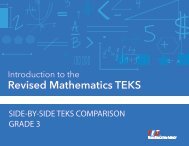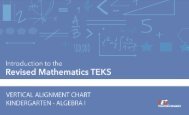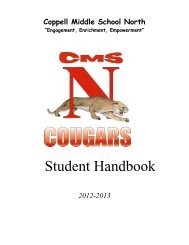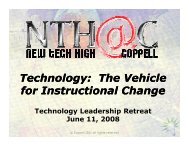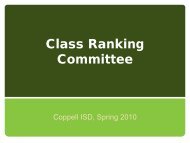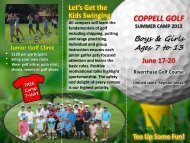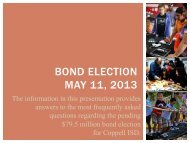Grade 2 - Coppell Independent School District
Grade 2 - Coppell Independent School District
Grade 2 - Coppell Independent School District
- No tags were found...
You also want an ePaper? Increase the reach of your titles
YUMPU automatically turns print PDFs into web optimized ePapers that Google loves.
SIDE-BY-SIDE TEKS COMPARISONGRADE 2
The materials are copyrighted (c) and trademarked (tm) as the property of the Texas Education Agency (TEA) and may not be reproducedwithout the express written permission of TEA, except under the following conditions:• Texas public school districts, charter schools, and Education Service Centers may reproduce and use copies of the Materialsand Related Materials for the districts’ and schools’ educational use without obtaining permission from TEA.• Residents of the state of Texas may reproduce and use copies of the Materials and Related Materials for individual personal useonly without obtaining written permission of TEA.• Any portion reproduced must be reproduced in its entirety and remain unedited, unaltered and unchanged in any way.• No monetary charge can be made for the reproduced materials or any document containing them; however, a reasonablecharge to cover only the cost of reproduction and distribution may be charged.Private entities or persons located in Texas that are not Texas public school districts, Texas Education Service Centers, or Texas charterschools or any entity, whether public or private, educational or non-educational, located outside the state of Texas MUST obtain writtenapproval from TEA and will be required to enter into a license agreement that may involve the payment of a licensing fee or a royalty.For information contact:Office of Copyrights, Trademarks, License Agreements, and Royalties,Texas Education Agency,1701 N. Congress Ave., Austin, TX 78701-1494;phone: 512-463-9270 or 512-463-9437;email: copyrights@tea.state.tx.us.©2013 Texas Education Agency All Rights Reserved 2013©2013 Texas Education Agency. All Rights Reserved 2013 Introduction to the Revised Mathematics TEKS: Side-By-Side TEKS Comparison
<strong>Grade</strong> 2 – MathematicsCurrent TEKS Revised TEKS (2012) Supporting Information NotesThe Revised TEKS (2012) include the use ofthe words “automaticity,” “fluency”/”fluently,”and “proficiency” with references to standardalgorithms. Attention is being given to thesedescriptors to indicate benchmark levels ofskill to inform intervention efforts at eachgrade level. These benchmark levels arealigned to national recommendations for thedevelopment of algebra readiness forenrollment in Algebra I.(a) Introduction.(3) Throughout mathematics inKindergarten-<strong>Grade</strong> 2, students developnumerical fluency with conceptualunderstanding and computationalaccuracy. Students in Kindergarten-<strong>Grade</strong>2 use basic number sense to composeand decompose numbers in order to solveproblems requiring precision, estimation,and reasonableness. By the end of <strong>Grade</strong>2, students know basic addition andsubtraction facts and are using them towork flexibly, efficiently, and accuratelywith numbers during addition andsubtraction computation.(a) Introduction.(3) For students to become fluent inmathematics, students must develop arobust sense of number. The NationalResearch Council’s report, “Adding ItUp,” defines procedural fluency as “skillin carrying out procedures flexibly,accurately, efficiently, andappropriately.” As students developprocedural fluency, they must alsorealize that true problem solving maytake time, effort, and perseverance.Students in <strong>Grade</strong> 2 are expected toperform their work without the use ofcalculators.Automaticity refers to the rapid recall of factsand vocabulary. For example, we would expecta fifth-grade student to recall rapidly the sumof 5 and 3 or to identify rapidly a closed figurewith 3 sides and 3 angles.To be mathematically proficient, students mustdevelop conceptual understanding, proceduralfluency, strategic competence, adaptivereasoning, and productive disposition (NationalResearch Council, 2001, p. 116).“Procedural fluency refers to knowledge ofprocedures, knowledge of when and how touse them appropriately, and skill in performingthem flexibly, accurately, and efficiently”(National Research Council, 2001, p. 121).“Students need to see that procedures can bedeveloped that will solve entire classes ofproblems, not just individual problems”(National Research Council, 2001, p. 121).Procedural fluency and conceptualunderstanding weave together to developmathematical proficiency.©2013 Texas Education Agency. All Rights Reserved 2013 Introduction to the Revised Mathematics TEKS: Side-by-Side TEKS Comparison 2
<strong>Grade</strong> 2 – MathematicsCurrent TEKS Revised TEKS (2012) Supporting Information Notes(a) Introduction.(4) Problem solving, language andcommunication, connections within andoutside mathematics, and formal andinformal reasoning underlie all contentareas in mathematics. Throughoutmathematics in Kindergarten-<strong>Grade</strong> 2,students use these processes togetherwith technology and other mathematicaltools such as manipulative materials todevelop conceptual understanding andsolve meaningful problems as they domathematics.(a) Introduction.(2) The process standards describe waysin which students are expected toengage in the content. The placement ofthe process standards at the beginning ofthe knowledge and skills listed for eachgrade and course is intentional. Theprocess standards weave the otherknowledge and skills together so thatstudents may be successful problemsolvers and use mathematics efficientlyand effectively in daily life. The processstandards are integrated at every gradelevel and course. When possible,students will apply mathematics toproblems arising in everyday life, society,and the workplace. Students will use aproblem-solving model that incorporatesanalyzing given information, formulatinga plan or strategy, determining asolution, justifying the solution, andevaluating the problem-solving processand the reasonableness of the solution.Students will select appropriate toolssuch as real objects, manipulatives,algorithms, paper and pencil, andtechnology and techniques such asmental math, estimation, number sense,generalization and abstraction to solveproblems. Students will effectivelycommunicate mathematical ideas,reasoning, and their implications usingmultiple representations such assymbols, diagrams, graphs, computerprograms, and language. Students willuse mathematical relationships togenerate solutions and make connectionsand predictions. Students will analyzemathematical relationships to connectand communicate mathematical ideas.Students will display, explain, or justifymathematical ideas and arguments usingprecise mathematical language in writtenor oral communication.This 2012 paragraph occurs second in theRevised TEKS (2012) instead of fourth as inthe current TEKS. This highlights the continuedemphasis on process skills that now continuefrom Kindergarten through high schoolmathematics.The language of this 2012 introductoryparagraph is very similar to the MathematicalProcess Standard strand within the RevisedTEKS (2012).This 2012 introductory paragraph includesgeneralization and abstraction with the textfrom (1)(C).This 2012 introductory paragraph includescomputer programs with the text from (1)(D).This 2012 introductory paragraph states,“students will use mathematical relationshipsto generate solutions and make connectionsand predictions” instead of the text from(1)(E).(a) Introduction.(5) Statements that contain the word"including" reference content that mustbe mastered, while those containing thephrase "such as" are intended as possibleillustrative examples.The State Board approved the retention ofsome “such as” statements within the TEKSwhere needed for clarification of content.©2013 Texas Education Agency. All Rights Reserved 2013 Introduction to the Revised Mathematics TEKS: Side-by-Side TEKS Comparison 3
<strong>Grade</strong> 2 – MathematicsCurrent TEKS: Number, Operation, andQuantitative ReasoningRevised TEKS (2012) Supporting Information Notes+++2(1)(A) Number, operation, andquantitative reasoning. The studentunderstands how place value is used torepresent whole numbers.The student is expected to use concretemodels of hundreds, tens, and ones torepresent a given whole number (up to999) in various ways.2(1)(B) Number, operation, andquantitative reasoning. The studentunderstands how place value is used torepresent whole numbers.The student is expected to use place valueto read, write, and describe the value ofwhole numbers to 999.2(2)(A) Number and operations. Thestudent applies mathematical processstandards to understand how to represent andcompare whole numbers, the relative positionand magnitude of whole numbers, andrelationships within the numeration systemrelated to place value.The student is expected to use concreteand pictorial models to compose anddecompose numbers up to 1,200 in morethan one way as a sum of so manythousands, hundreds, tens, and ones.2(2)(B) Number and operations. Thestudent applies mathematical processstandards to understand how to represent andcompare whole numbers, the relative positionand magnitude of whole numbers, andrelationships within the numeration systemrelated to place value.The student is expected to use standard,word, and expanded forms to representnumbers up to 1,200.2(2)(C) Number and operations. Thestudent applies mathematical processstandards to understand how to represent andcompare whole numbers, the relative positionand magnitude of whole numbers, andrelationships within the numeration systemrelated to place value.The student is expected to generate anumber that is greater than or less than agiven whole number up to 1,200.Specificity has been added with rephrasing“Represent….in various ways” as “use concreteand pictorial models to compose anddecompose numbers.”Specificity has been added with “sum of somany thousands, hundreds, tens, and ones.” Itmay include decomposing 787 into 7 hundreds,8 tens, and 7 ones. It may also includedecomposing 787 into the sum of 500, 200, 50,30, and 7 to prepare for work with compatiblenumbers when adding whole numbers withfluency.The number has increased from “up to 999” to“up to 1,200.” Students are expected to usepictorial models in addition to concrete models.The Revised SE 2012 has been made moreconcise by replacing “read, write and describe”with “represent.”Specificity has been added for what is to berepresented (read, written, and described):“standard, word, and expanded forms” in placeof “place value.”The number has increased from “up to 999” to“up to 1,200.”This revised SE extends revised SE K(2)(F)where students are expected to generate anumber that is one more or one less thananother number up to 20 and revised SE1(5)(C) where students are expected todetermine the number that is 10 more and 10less than a given number up to 120.©2013 Texas Education Agency. All Rights Reserved 2013 Introduction to the Revised Mathematics TEKS: Side-by-Side TEKS Comparison 4
<strong>Grade</strong> 2 – MathematicsCurrent TEKS: Number, Operation, andQuantitative ReasoningRevised TEKS (2012) Supporting Information Notes++2(1)(C) Number, operation, andquantitative reasoning. The studentunderstands how place value is used torepresent whole numbers.The student is expected to use place valueto compare and order whole numbers to999 and record the comparisons usingnumbers and symbols ().2(2)(A) Number, operation, andquantitative reasoning. The studentdescribes how fractions are used to name partsof whole objects or sets of objects.The student is expected to use concretemodels to represent and name fractionalparts of a whole object (withdenominators of 12 or less).2(2)(D) Number and operations. Thestudent applies mathematical processstandards to understand how to represent andcompare whole numbers, the relative positionand magnitude of whole numbers, andrelationships within the numeration systemrelated to place value.The student is expected to use place valueto compare and order whole numbers to1,200 using comparative language,numbers, and symbols (>,
<strong>Grade</strong> 2 – MathematicsCurrent TEKS: Number, Operation, andQuantitative ReasoningRevised TEKS (2012) Supporting Information Notes–2(2)(A) Number, operation, andquantitative reasoning. The studentdescribes how fractions are used to name partsof whole objects or sets of objects.The student is expected to use concretemodels to represent and name fractionalparts of a whole object (withdenominators of 12 or less).2(2)(B) Number, operation, andquantitative reasoning. The studentdescribes how fractions are used to name partsof whole objects or sets of objects.The student is expected to use concretemodels to represent and name fractionalparts of a set of objects (withdenominators of 12 or less).2(3)(D) Number and operations. Thestudent applies mathematical processstandards to recognize and represent fractionalunits and communicates how they are used toname parts of a whole.The student is expected to identifyexamples and non-examples of halves,fourths, and eighths.Specificity has been added to illustrate howstudents might justify their thinking related tohalves, fourths, and eighths.The content of this SE was moved to grade 3:Number and operations3(3)(E)–+2(2)(C) Number, operation, andquantitative reasoning. The studentdescribes how fractions are used to name partsof whole objects or sets of objects.The student is expected to use concretemodels to determine if a fractional part ofa whole is closer to 0, ½, or 1.2(3)(A) Number, operation, andquantitative reasoning. The student addsand subtracts whole numbers to solveproblems.The student is expected to recall andapply basic addition and subtraction facts(to 18).2(4)(A) Number and operations. Thestudent applies mathematical processstandards to develop and use strategies andmethods for whole number computations inorder to solve addition and subtractionproblems with efficiency and accuracy.The student is expected to recall basicfacts to add and subtractwithin 20 with automaticity.This skill, when coupled with revised SE3(1)(C), becomes part of the revised SE3(3)(H).Students are expected to recall basic additionand subtraction facts.When coupled with revised SE, students maystill be asked to apply these basic facts.The level of skill with “automaticity” requiresquick recall of basic facts within 20 with speedand accuracy at an unconscious level.Automaticity is part of procedural fluency and,as such, should not be overly emphasized as anisolated skill.Automaticity with basic addition andsubtraction facts allows students to explorericher applications of addition and subtraction.This is an increase from within 18.©2013 Texas Education Agency. All Rights Reserved 2013 Introduction to the Revised Mathematics TEKS: Side-by-Side TEKS Comparison 6
<strong>Grade</strong> 2 – MathematicsCurrent TEKS: Number, Operation, andQuantitative ReasoningRevised TEKS (2012) Supporting Information Notes+2(3)(B) Number, operation, andquantitative reasoning. The student addsand subtracts whole numbers to solveproblems.The student is expected to model additionand subtraction of two-digit numbers withobjects, pictures, words, and number.2(3)(C) Number, operation, andquantitative reasoning. The student addsand subtracts whole numbers to solveproblems.The student is expected to select additionor subtraction to solve problems usingtwo-digit numbers, whether or notregrouping is necessary.2(7)(C) Algebraic reasoning. The studentapplies mathematical process standards toidentify and apply number patterns withinproperties of numbers and operations in orderto describe relationships.The student is expected to represent andsolve addition and subtraction wordproblems where unknowns may be anyone of the terms in the problem.2(4)(B) Number and operations. Thestudent applies mathematical processstandards to develop and use strategies andmethods for whole number computations inorder to solve addition and subtractionproblems with efficiency and accuracy.The student is expected to add up to fourtwo-digit numbers and subtract two-digitnumbers using mental strategies andalgorithms based on knowledge of placevalue and properties of operations.2(4)(C) Number and operations. Thestudent applies mathematical processstandards to develop and use strategies andmethods for whole number computations inorder to solve addition and subtractionproblems with efficiency and accuracy.The student is expected to solve one-stepand multi-step word problems involvingaddition and subtraction within 1,000using a variety of strategies based onplace value, including algorithms.When paired with revised SEs 2(1)(C) and2(1)(D), the expectation is that studentsrepresent problems with objects,manipulatives, diagrams, language, andnumber.The action of solving with the revised SE2(7)(C) aligns to the current 2(3)(C) as well.Specificity has been added for the number ofvalues to be used when adding and subtractingwith two-digit numbers.This specificity does not constrain the workwith addition and subtraction in other SEs.Specificity has been added regarding strategiesused to solve problems.Students are still expected to “regroup” as theyapply mental strategies and algorithms basedon knowledge of place value and property ofoperations.The revised SE includes the addition andsubtraction of 3 digit numbers.The constraint of “within 1,000” has beenadded.Specificity has been added as to the type ofword problems students may be expected tosolve. Problems may be one-step of multi-step.Paired with 2(4)(B), the problems in 2(4)(C)would be limited to addition of "up to four twodigitnumbers" and subtraction of "two-digitnumbers."Strategies may include properties ofoperations. For example, 432+241 may bethought of as (400+200)+(30+40)+(2+1).Specificity has been added regarding strategiesused to solve problems.Fluency with this skill occurs in grade 3.2(4)(D) Number and operations. Thestudent applies mathematical processstandards to develop and use strategies andmethods for whole number computations inorder to solve addition and subtractionproblems with efficiency and accuracy.The revised SE includes the addition andsubtraction of 3 digit numbers.Students must be provided with amathematical number sentence in order togenerate and then solve their problem©2013 Texas Education Agency. All Rights Reserved 2013 Introduction to the Revised Mathematics TEKS: Side-by-Side TEKS Comparison 7
<strong>Grade</strong> 2 – Mathematics2(3)(D) Number, operation, andquantitative reasoning. The student addsand subtracts whole numbers to solveproblems.The student is expected to determine thevalue of a collection of coins up to onedollar.2(3)(E) Number, operation, andquantitative reasoning. The student addsand subtracts whole numbers to solveproblems.The student is expected to describe howthe cent symbol, dollar symbol, and thedecimal point are used to name the valueof a collection of coins.2(4)(A) Number, operation, andquantitative reasoning. The student modelsmultiplication and division.The student is expected to model, create,and describe multiplication situations inwhich equivalent sets of concrete objectsare joined.2(4)(B) Number, operation, andquantitative reasoning. The student modelsmultiplication and division.The student is expected to model, create,and describe division situations in which aset of concrete objects is separated intoequivalent sets.The student is expected to generate andsolve problem situations for a givenmathematical number sentence involvingaddition and subtraction of wholenumbers within 1,000.2(5)(A) Number and operations. Thestudent applies mathematical processstandards to determine the value of coins inorder to solve monetary transactions.The student is expected to determine thevalue of a collection of coins up to onedollar.2(5)(B) Number and operations. Thestudent applies mathematical processstandards to determine the value of coins inorder to solve monetary transactions.The student is expected to use the centsymbol, dollar sign, and the decimal pointto name the value of a collection of coins.2(6)(A) Number and operations. Thestudent applies mathematical processstandards to connect repeated addition andsubtraction to multiplication and divisionsituations that involve equal groupings andshares.The student is expected to model, create,and describe contextual multiplicationsituations in which equivalent sets ofconcrete objects are joined.2(6)(B) Number and operations. Thestudent applies mathematical processstandards to connect repeated addition andsubtraction to multiplication and divisionsituations that involve equal groupings andshares.The student is expected to model, create,and describe contextual division situationsin which a set of concrete objects isseparated into equivalent sets.situations.This SE remains unchanged.Students are expected to use the notation formoney rather than describe their use.The phrase “multiplication situations” has beenrephrased with “contextual multiplicationsituations.” The situations are not purelymathematical situations.The phrase “division situations” has beenrephrased with “contextual division situations.”The situations are not purely mathematicalsituations.©2013 Texas Education Agency. All Rights Reserved 2013 Introduction to the Revised Mathematics TEKS: Side-by-Side TEKS Comparison 8
<strong>Grade</strong> 2 – MathematicsCurrent TEKS: Patterns, Relationships, andAlgebraic ThinkingRevised TEKS (2012) Supporting Information Notes–2(5)(A) Patterns, relationships, andalgebraic thinking. The student uses patternsin numbers and operations.The student is expected to find patterns innumbers such as in a 100s chart.2(5)(B) Patterns, relationships, andalgebraic thinking. The student uses patternsin numbers and operations.2(2)(D) Number and operations. Thestudent applies mathematical processstandards to understand how to represent andcompare whole numbers, the relative positionand magnitude of whole numbers, andrelationships within the numeration systemrelated to place value.The student is expected to use place valueto compare and order whole numbers to1,200 using comparative language,numbers, and symbols (>,
<strong>Grade</strong> 2 – Mathematics–––Current TEKS: Patterns, Relationships, andAlgebraic Thinking2(6)(A) Patterns, relationships, andalgebraic thinking. The student uses patternsto describe relationships and make predictions.The student is expected to generate a listof paired numbers based on a real-lifesituation such as number of tricyclesrelated to number of wheels.2(6)(B) Patterns, relationships, andalgebraic thinking. The student uses patternsto describe relationships and make predictions.The student is expected to identifypatterns in a list of related number pairsbased on a real-life situation and extendthe list.2(6)(C) Patterns, relationships, andalgebraic thinking. The student uses patternsto describe relationships and make predictions.The student is expected to identify,describe, and extend repeating andadditive patterns to make predictions andsolve problems.Revised TEKS (2012) Supporting Information NotesThe content of this SE was moved to grade 3:Algebraic reasoning3(5)(E)The content of this SE was moved to grade 3:Algebraic reasoning3(5)(E)Repeating patterns have been removed fromthe Revised TEKS (2012).Patterns that are additive in nature havemoved to grade 5:Algebraic reasoning5(4)(C)5(4)(D)+2(7)(A) Algebraic reasoning. The studentapplies mathematical process standards toidentify and apply number patterns withinproperties of numbers and operations in orderto describe relationships.The student is expected to determinewhether a number up to 40 is even or oddusing pairings of objects to represent thenumber.The revised SE comes from the current grade 1TEKS:Patterns, relationships, and algebraic thinking1(5)(B).Specificity has been added with the “pairings ofobjects” rather than “patterns.”©2013 Texas Education Agency. All Rights Reserved 2013 Introduction to the Revised Mathematics TEKS: Side-by-Side TEKS Comparison 10
<strong>Grade</strong> 2 – Mathematics–+Current TEKS: Geometry and SpatialReasoning2(7)(A) Geometry and spatial reasoning.The student uses attributes to identify two- andthree-dimensional geometric figures. Thestudent compares and contrasts two-and threedimensionalgeometric figures or both.The student is expected to describeattributes (the number of vertices, faces,edges, sides) of two- and threedimensionalgeometric figures such ascircles, polygons, spheres, cones,cylinders, prisms, and pyramids, etc.2(7)(B) Geometry and spatial reasoning.The student uses attributes to identify two- andthree-dimensional geometric figures. Thestudent compares and contrasts two-and threedimensionalgeometric figures or both.The student is expected to use attributesto describe how 2 two-dimensional figuresor 2 three-dimensional geometric figuresare alike or different.Revised TEKS (2012) Supporting Information Notes2(8)(B) Geometry and measurement. Thestudent applies mathematical processstandards to analyze attributes of twodimensionalshapes and three-dimensionalsolids to develop generalizations about theirproperties.The student is expected to classify andsort three-dimensional solids includingspheres, cones, cylinders, rectangularprisms (including cubes as specialrectangular prisms), and triangularprisms, based on attributes using formalgeometric language.2(8)(C) Geometry and measurement.The student applies mathematical processstandards to analyze attributes of twodimensionalshapes and three-dimensionalsolids to develop generalizations about theirproperties.The content of this SE was moved to grade 1:Geometry and measurement1(6)(D)1(6)(E)Specificity regarding 3-d figures has beenadded.Formal geometric language includes terms suchas “vertex,” “edge,” and “face.”The revised SE has added depth withclassification of solids. The comparison ofsimilarities and differences supportsclassification and sorting.Specificity regarding 2-d figures has beenadded.2(7)(C) Geometry and spatial reasoning.The student uses attributes to identify two- andthree-dimensional geometric figures. Thestudent compares and contrasts two-and threedimensionalgeometric figures or both.The student is expected to cut twodimensionalgeometric figures apart andidentify the new geometric figures formed.The student is expected to classify andsort polygons with 12 or fewer sidesaccording to attributes, includingidentifying the number of sides andnumber of vertices.2(8)(E) Geometry and measurement.The student applies mathematical processstandards to analyze attributes of twodimensionalshapes and three-dimensionalsolids to develop generalizations about theirproperties.The student is expected to decomposetwo-dimensional shapes such as cuttingout a square from a rectangle, dividing ashape in half, or partitioning a rectangleinto identical triangles and identify theresulting geometric parts.The revised SE has added depth withclassification of polygons. The comparison ofsimilarities and differences supportsclassification.The word “cut” has been replaced with themore appropriate word “decompose.”An example of how a student might decomposea 2-D shape has been provided.In grade 2, the focus on decomposing shapescomplements the work with fractional parts of awhole.©2013 Texas Education Agency. All Rights Reserved 2013 Introduction to the Revised Mathematics TEKS: Side-by-Side TEKS Comparison 11
<strong>Grade</strong> 2 – MathematicsCurrent TEKS: Geometry and SpatialReasoning2(8) Geometry and spatial reasoning.The student recognizes that a line can be usedto represent a set of numbers and itsproperties.The student is expected to use wholenumbers to locate and name points on anumber line.Revised TEKS (2012) Supporting Information Notes2(2)(E) Number and operations. Thestudent applies mathematical processstandards to understand how to represent andcompare whole numbers, the relative positionand magnitude of whole numbers, andrelationships within the numeration systemrelated to place value.The student is expected to locate theposition of a given whole number on anopen number line.2(2)(F) Number and operations. Thestudent applies mathematical processstandards to understand how to represent andcompare whole numbers, the relative positionand magnitude of whole numbers, andrelationships within the numeration systemrelated to place value.The student is expected to name thewhole number that corresponds to aspecific point on a number line.The use of an open number line has beenspecified.The current SE was been separated into twoRevised SEs (2012).The current SE was been separated into twoRevised SEs (2012).++2(8)(A) Geometry and measurement.The student applies mathematical processstandards to analyze attributes of twodimensionalshapes and three-dimensionalsolids to develop generalizations about theirproperties.The student is expected to create twodimensionalshapes based on givenattributes, including number of sides andvertices.2(8)(D) Geometry and measurement.The student applies mathematical processstandards to analyze attributes of twodimensionalshapes and three-dimensionalsolids to develop generalizations about theirproperties.The student is expected to compose twodimensionalshapes and three-dimensionalsolids with given properties or attributes.The revised SE comes from the current grade 1TEKS:Geometry1(5)(D)Students are expected to create shapes basedon given attributes rather than given concretemodels.The revised SE comes from the current grade 1TEKS:Geometry1(5)(D)Students are expected to compose 2-d shapesand 3-d solids such as building a rectangle outof unit squares or building a rectangular prismout of unit cubes.Students are expected to compose givenproperties.©2013 Texas Education Agency. All Rights Reserved 2013 Introduction to the Revised Mathematics TEKS: Side-by-Side TEKS Comparison 12
<strong>Grade</strong> 2 – MathematicsCurrent TEKS: Measurement Revised TEKS (2012) Supporting Information Notes+2(9)(A) Measurement. The student directlycompares the attributes of length, area,weight/mass, and capacity, and usescomparative language to solve problems andanswer questions. The student selects and usesnonstandard units to describe length, area,capacity, and weight/mass. The studentrecognizes and uses models that approximatestandard units (from both SI, also known asmetric, and customary systems) of length,weight/mass, capacity, and time.The student is expected to identifyconcrete models that approximatestandard units of length and use them tomeasure length.2(9)(A) Geometry and measurement.The student applies mathematical processstandards to select and use units to describelength, area, and time.The student is expected to find the lengthof objects using concrete models forstandard units of length.2(9)(B) Geometry and measurement.The student applies mathematical processstandards to select and use units to describelength, area, and time.The student is expected to describe theinverse relationship between the size ofthe unit and the number of units neededto equal the length of an object.2(9)(C) Geometry and measurement.The student applies mathematical processstandards to select and use units to describelength, area, and time.The student is expected to representwhole numbers as distances from anygiven location on a number line.2(9)(D) Geometry and measurement.The student applies mathematical processstandards to select and use units to describelength, area, and time.The student is expected to determine thelength of an object to the nearest markedunit using rulers, yardsticks, meter sticks,or measuring tapes.Greater specificity has been added with therevised SE by breaking the current SE 2(9)(A)into its component parts.The concrete models should represent ratherthan approximate a standard unit of lengthsuch as the edges of inch tiles or centimetercubes.Greater specificity has been added with therevised SE by breaking the current SE 2(9)(A)into its component parts. A student is expectedto provide a description such as “the longer theunit, the fewer needed and the shorter theunit, the more needed to measure a length.”The revised SE has added number lines as arepresentation of distance (length).Greater specificity has been added with therevised SE by breaking the current SE 2(9)(A)into its component parts.Students are expected to use standard units oflength and measure to the nearest whole unitsuch as an inch or a foot.2(9)(E) Geometry and measurement.The student applies mathematical processstandards to select and use units to describelength, area, and time.The student is expected to determine asolution to a problem involving length,including estimating lengths.Greater specificity has been added with therevised SE by breaking the current SE 2(9)(A)into its component parts.©2013 Texas Education Agency. All Rights Reserved 2013 Introduction to the Revised Mathematics TEKS: Side-by-Side TEKS Comparison 13
<strong>Grade</strong> 2 – MathematicsCurrent TEKS: Measurement Revised TEKS (2012) Supporting Information Notes2(9)(B) Measurement. The student directlycompares the attributes of length, area,weight/mass, and capacity, and usescomparative language to solve problems andanswer questions. The student selects and usesnonstandard units to describe length, area,capacity, and weight/mass. The studentrecognizes and uses models that approximatestandard units (from both SI, also known asmetric, and customary systems) of length,weight/mass, capacity, and time.The student is expected to select a nonstandardunit of measure such as squaretiles to determine the area of a twodimensionalsurface.2(9)(F) Geometry and measurement.The student applies mathematical processstandards to select and use units to describelength, area, and time.The student is expected to use concretemodels of square units to find the area ofa rectangle by covering it with no gaps oroverlaps, counting to find the totalnumber of square units, and describingthe measurement using a number and theunit.Specificity has been added as to how studentsare expected to use square units to determinethe area of a 2-d figure.The 2-d figure has been constrained torectangles, which includes squares.The concrete models should be square units,and the measurement should be describedusing square units such as “24 square units.”––2(9)(C) Measurement. The student directlycompares the attributes of length, area,weight/mass, and capacity, and usescomparative language to solve problems andanswer questions. The student selects and usesnonstandard units to describe length, area,capacity, and weight/mass. The studentrecognizes and uses models that approximatestandard units (from both SI, also known asmetric, and customary systems) of length,weight/mass, capacity, and time.The student is expected to select a nonstandardunit of measure such as abathroom cup or a jar to determine thecapacity of a given container.2(9)(D) Measurement. The student directlycompares the attributes of length, area,weight/mass, and capacity, and usescomparative language to solve problems andanswer questions. The student selects and usesnonstandard units to describe length, area,capacity, and weight/mass. The studentrecognizes and uses models that approximatestandard units ( from both SI, also known asmetric, and customary systems) of length,weight/mass, capacity, and time.The student is expected to select a nonstandardunit of measure such as beans ormarbles to determine the weight/mass ofa given object.This skill is not included within the RevisedTEKS (2012).This skill may support instruction related toKindergarten:Geometry and measurementK(7)(A)This skill is not included within the RevisedTEKS (2012).This skill may support instruction related toKindergarten:Geometry and measurementK(7)(A)©2013 Texas Education Agency. All Rights Reserved 2013 Introduction to the Revised Mathematics TEKS: Side-by-Side TEKS Comparison 14
<strong>Grade</strong> 2 – MathematicsCurrent TEKS: Measurement Revised TEKS (2012) Supporting Information Notes–2(10)(A) Measurement. The student usesstandard tools to estimate and measure timeand temperature (in degrees Fahrenheit).The student is expected to read athermometer to gather data.This skill is not included within the RevisedTEKS (2012).+2(10)(B) Measurement. The student usesstandard tools to estimate and measure timeand temperature (in degrees Fahrenheit).The student is expected to read and writetimes shown on analog and digital clocksusing five-minute increments.2(9)(G) Geometry and measurement.The student applies mathematical processstandards to select and use units to describelength, area, and time.The student is expected to read and writetime to the nearest one-minute incrementusing analog and digital clocks anddistinguish between a.m. and p.m.Specificity has been added with distinguishingbetween a.m. and p.m.Reading and writing time now takes place tothe nearest minute rather than five-minuteincrement.–2(10)(C) Measurement. The student usesstandard tools to estimate and measure timeand temperature (in degrees Fahrenheit).The student is expected to describeactivities that take approximately onesecond, one minute, and one hour.This skill is not included within the RevisedTEKS (2012).©2013 Texas Education Agency. All Rights Reserved 2013 Introduction to the Revised Mathematics TEKS: Side-by-Side TEKS Comparison 15
<strong>Grade</strong> 2 – MathematicsCurrent TEKS: Probability and Statistics Revised TEKS (2012) Supporting Information Notes2(11)(A) Probability and statistics.The student organizes data to make it usefulfor interpreting information.2(10)(B) Data analysis. The student appliesmathematical process standards to organizedata to make it useful for interpretinginformation and solving problems.The student is expected to organize acollection of data with up to fourcategories using pictographs and bargraphs with intervals of oneor more.The number of categories has been constrainedto four.Intervals may be one or more.+The student is expected to constructpicture graphs and bar-type graphs.2(11)(B) Probability and statistics.The student organizes data to make it usefulfor interpreting information.The student is expected to drawconclusions and answer questions basedon picture graphs and bar-type graphs.2(11)(C) Probability and statistics.The student organizes data to make it usefulfor interpreting information.2(10)(A) Data analysis. The student appliesmathematical process standards to organizedata to make it useful for interpretinginformation and solving problems.The student is expected to explain that thelength of a bar in a bar graph or thenumber of pictures in a pictographrepresents the number of data points for agiven category.2(10)(D) Data analysis. The student appliesmathematical process standards to organizedata to make it useful for interpretinginformation and solving problems.The student is expected to drawconclusions and make predictions frominformation in a graph.2(10)(C) Data analysis. The student appliesmathematical process standards to organizedata to make it useful for interpretinginformation and solving problems.The student is expected to write and solveone-step word problems involving additionor subtraction using data representedwithin pictographs and bar graphs withintervals of one.Specificity has been added in how students areexpected to be able to explain theirconstruction of a picture graph (pictograph) ora bar-type graph (bar graph).Specificity has been added regarding the typesof questions. The questions for this SE willfocus on making predictions.Pairing this SE with revised SEs 2(10)(A) and2(10)(B)shows that the graphs are pictographsand bar graphs.Specificity has been added regarding the typesof questions students are expected to answer.Specificity has been added regarding intervalson the graphs.Students are now expected to write problemsinvolving addition or subtraction using datarepresented within the stated graphs.–The student is expected to use data todescribe events as more likely or lesslikely such as drawing a certain colorcrayon from a bag of seven red crayonsand three green crayons.This skill is not included within the RevisedTEKS (2012).©2013 Texas Education Agency. All Rights Reserved 2013 Introduction to the Revised Mathematics TEKS: Side-by-Side TEKS Comparison 16
<strong>Grade</strong> 2 – MathematicsCurrent TEKS: Underlying Processes andMathematical ToolsRevised TEKS (2012) Supporting Information Notes2(12)(A) Underlying processes andmathematical tools. The student applies<strong>Grade</strong> 2 mathematics to solve problemsconnected to everyday experiences andactivities in and outside of school.The student is expected to identify themathematics in everyday situations.2(12)(B) Underlying processes andmathematical tools. The student applies<strong>Grade</strong> 2 mathematics to solve problemsconnected to everyday experiences andactivities in and outside of school.The student is expected to solve problemswith guidance that incorporates theprocesses of understanding the problem,making a plan, carrying out the plan, andevaluating the solution forreasonableness.2(12)(C) Underlying processes andmathematical tools. The student applies<strong>Grade</strong> 2 mathematics to solve problemsconnected to everyday experiences andactivities in and outside of school.The student is expected to select ordevelop an appropriate problem-solvingplan or strategy including drawing apicture, looking for a pattern, systematicguessing and checking, or acting it out inorder to solve a problem.2(1)(A) Mathematical process standards.The student uses mathematical processes toacquire and demonstrate mathematicalunderstanding.The student is expected to applymathematics to problems arising ineveryday life, society, and the workplace.2(1)(B) Mathematical process standards.The student uses mathematical processes toacquire and demonstrate mathematicalunderstanding.The student is expected to use a problemsolvingmodel that incorporates analyzinggiven information, formulating a plan orstrategy, determining a solution, justifyingthe solution, and evaluating the problemsolvingprocess and the reasonableness ofthe solution.The focus has shifted to application.The opportunities for application have beenconsolidated into three areas: everyday life,society, and the workplace.The revised SE, when tagged to a content SE,allows for increased rigor through connectionsoutside the discipline.The revised SE restates and condenses2(12)(B) and 2(12)(C).Problem-Solving ModelCurrent TEKS Revised TEKS(2012)Understanding theproblemMaking a planCarrying out theplanEvaluating thesolution forreasonablenessAnalyzing giveninformationFormulating a planor strategyDetermining asolutionJustifying thesolutionEvaluating theproblem-solvingprocess and thereasonableness ofthe solution2(12)(D) Underlying processes andmathematical tools. The student applies<strong>Grade</strong> 2 mathematics to solve problemsconnected to everyday experiences andactivities in and outside of school.The student is expected to use tools suchas real objects, manipulatives, andtechnology to solve problems.2(1)(C) Mathematical process standards.The student uses mathematical processes toacquire and demonstrate mathematicalunderstanding.The student is expected to select tools,including real objects, manipulatives,paper and pencil, and technology asappropriate, and techniques, includingmental math, estimation, and numbersense as appropriate, to solve problems.The phrase “as appropriate” has been insertedinto the Revised TEKS (2012). This implies thatstudents are assessing which tool to applyrather than trying only one or all.“Paper and pencil” is now included in the list oftools that still includes real objects,manipulatives, and technology.©2013 Texas Education Agency. All Rights Reserved 2013 Introduction to the Revised Mathematics TEKS: Side-by-Side TEKS Comparison 17
<strong>Grade</strong> 2 – MathematicsCurrent TEKS: Underlying Processes andMathematical Tools2(13)(A) Underlying processes andmathematical tools. The studentcommunicates about <strong>Grade</strong> 2 mathematicsusing informal language.The student is expected to explain andrecord observations using objects, words,pictures, numbers, and technology.Revised TEKS (2012) Supporting Information Notes2(1)(D) Mathematical process standards.The student uses mathematical processes toacquire and demonstrate mathematicalunderstanding.The student is expected to communicatemathematical ideas, reasoning, and theirimplications using multiplerepresentations, including symbols,diagrams, graphs, and language asappropriate.Communication has expanded to includereasoning and the implications of mathematicalideas and reasoning.The list of representations is now summarizedwith “multiple representations” with specificityadded for symbols and diagrams.2(13)(B) Underlying processes andmathematical tools. The studentcommunicates about <strong>Grade</strong> 2 mathematicsusing informal language.The student is expected to relate informallanguage to mathematical language andsymbols.2(14) Underlying processes andmathematical tools. The student uses logicalreasoning.The student is expected to justify his orher thinking using objects, words,pictures, numbers, and technology.2(1)(E) Mathematical process standards.The student uses mathematical processes toacquire and demonstrate mathematicalunderstanding.The student is expected to create and userepresentations to organize, record, andcommunicate mathematical ideas.2(1)(F) Mathematical process standards.The student uses mathematical processes toacquire and demonstrate mathematicalunderstanding.The student is expected to analyzemathematical relationships to connect andcommunicate mathematical ideas.2(1)(G) Mathematical process standards.The student uses mathematical processes toacquire and demonstrate mathematicalunderstanding.The student is expected to display,explain, and justify mathematical ideasand arguments using precisemathematical language in written or oralcommunications.The use of representations is extended toinclude organizing and recording mathematicalideas in addition to communicating.As students use and create representations, itis implied that they will evaluate theeffectiveness of their representations to ensurethat they are communicating mathematicalideas clearly.Students are expected to use appropriatemathematical vocabulary and phrasing whencommunicating mathematical ideas.The Revised TEKS (2012) extends the currentTEKS to allow for additional means to analyzerelationships and to form connections withmathematical ideas past conjecturing and setsof examples and non-examples.Students are still expected to form conjecturesbased on patterns or sets of examples andnon-examples.The Revised TEKS (2012) clarifies “validateshis/her conclusions” with displays,explanations, and justifications. Theconclusions are expected to focus onmathematical ideas and arguments.Displays could include diagrams, visual aids,written work, etc. The intention is make one’swork visible to others so that explanations andjustifications may be shared in written or oralform.Precise mathematical language is expected. Forexample, students would use “vertex” insteadof “corner” when referring to the point at whichtwo edges intersect on a polygon.©2013 Texas Education Agency. All Rights Reserved 2013 Introduction to the Revised Mathematics TEKS: Side-by-Side TEKS Comparison 18
<strong>Grade</strong> 2 – MathematicsCurrent TEKS Revised TEKS (2012) Supporting Information Notes++++++2(11)(A) Personal financial literacy.The student applies mathematical processstandards to manage one’s financial resourceseffectively for lifetime financial security.The student is expected to calculate howmoney saved can accumulate into a largeramount over time.2(11)(B) Personal financial literacy.The student applies mathematical processstandards to manage one’s financial resourceseffectively for lifetime financial security.The student is expected to explain thatsaving is an alternative to spending.2(11)(C) Personal financial literacy.The student applies mathematical processstandards to manage one’s financial resourceseffectively for lifetime financial security.The student is expected to distinguishbetween a deposit and a withdrawal.2(11)(D) Personal financial literacy.The student applies mathematical processstandards to manage one’s financial resourceseffectively for lifetime financial security.The student is expected to identifyexamples of borrowing and distinguishbetween responsible and irresponsibleborrowing.2(11)(E) Personal financial literacy.The student applies mathematical processstandards to manage one’s financial resourceseffectively for lifetime financial security.The student is expected to identifyexamples of lending and use concepts ofbenefits and costs to evaluate lendingdecisions.2(11)(F) Personal financial literacy.The student applies mathematical processstandards to manage one’s financial resourceseffectively for lifetime financial security.The student is expected to differentiatebetween producers and consumers andcalculate the cost to produce a simpleitem.Simple items may include items such as a shirt,a pitcher of lemonade, or a class art project.©2013 Texas Education Agency. All Rights Reserved 2013 Introduction to the Revised Mathematics TEKS: Side-by-Side TEKS Comparison 19






